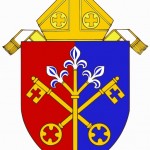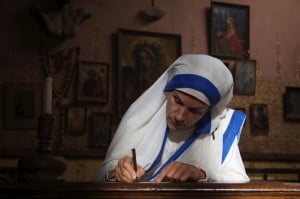When you walk into the church, you dip your fingers into the holy water font and then make the sign of the cross. But why do you do that?
Why do Catholics use holy water in their worship and their devotional life?
* * * * *
Numbers 5:17
“And he shall take holy water in an earthen vessel, and he shall cast a little earth of the pavement of the tabernacle into it.”
The Catholic Church teaches that Christ instituted seven “sacraments”–means by which grace is conferred.
But beyond that, the Church recognizes other aids to devotion, such as medals, rosaries, scapulars and statues, which they call “sacramentals”. Actions (such as the sign of the cross) can be sacramentals, as well. Holy water, like those other aids to piety, is a “sacramental.”
When you dip your finger into the holy water font at the entrance to the church and make the sign of the cross, you are touching your forehead (your mind), your shoulders and your heart with a sacramental. If this simple action is performed in faith, it imparts grace to the believer.
HOLY WATER IN THE SCRIPTURES
In the Scriptures, Israelite priests used to purify people and places by sprinkling them with water (see Leviticus 14:49-52 and Numbers 19-18). Likewise, in Numbers 5 (written above), God calls on His people to use holy water in a blessing.
Israelite priests used water ritually, to wash their hands before and after offering sacrifices. And the great Temple in Jerusalem had fonts at the entrances, in which worshippers could cleanse themselves before entering.
HOLY WATER IN THE LITURGY
In the Mass, the priest washes his hands at the beginning of the Liturgy of the Eucharist, as he prepares to offer the bread and wine which will be consecrated and will become the Body and Blood of Christ.
HOLY WATER IN BAPTISM
In Matthew 28:19, Jesus instructed His disciples, “Go therefore and make disciples of all the nations, baptizing them in the name of the Father and the Son and the Holy Spirit.”
In the sacrament of Baptism, holy water is the material substance used by God to effect the remission of sins.
WHERE DOES HOLY WATER COME FROM?
Plain water is made holy when it is blessed by a priest. At the Easter Vigil, water is blessed for the baptism of those being received into the Church that night. In the past, this holy water was retained for use throughout the liturgical year. Now, the custom is to use fresh water for baptisms outside of the Easter season.
Once it is blessed, the holy water is reserved in a receptacle that is accessible to worshippers. Most churches have small fonts at the entrance to the church; some churches now have large baptismal fonts that sit in the vestibule or at the entrance to the church. The faithful, upon entering the church, dip their fingers into the font and make the sign of the cross, as a preparation for the liturgy.
The holy water reminds us of our baptism and our union with Christ. The imagery of “washing” helps us to remember that we need to be cleansed and forgiven for our sins.
* * * * *
From those creative guys at Spirit Juice Productions and Paulist Evangelization Ministries, a YouTube video that explains the whole thing:











